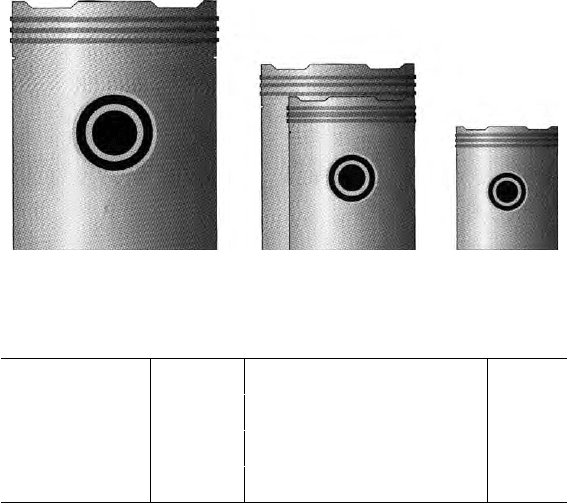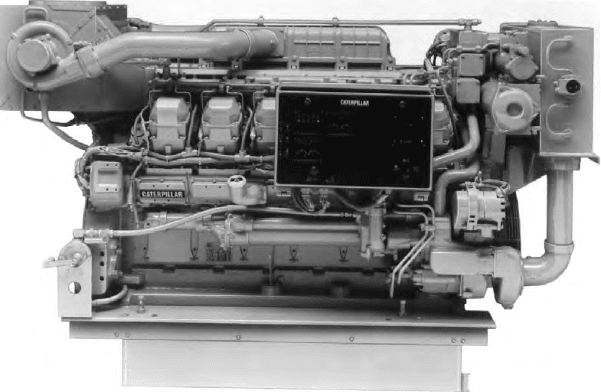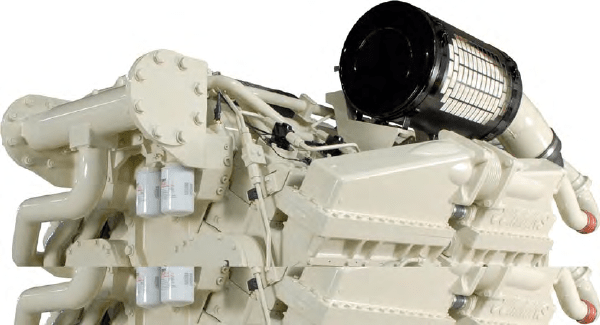Woodyard D. (ed.) Pounders Marine diesel engines and Gas Turbines
Подождите немного. Документ загружается.


versions, all produced in six-cylinder form only and featuring a stroke/bore ratio
of 2:1. An output band from 2058 kW to 2430 kW at 240 rev/min is covered by
the 6EL38 and 6EL40 engines on a mean effective pressure of around 20 bar.
The bedplate, crankcase and cylinder block are of cast iron and form a
highly rigid construction. The exhaust valve is provided with a cage and rota-
tor, and the valve seat faces are stellited. The cylinder liner is supported at
its shoulder by an annular piece to prevent it from deforming due to thermal
expansion. No separate cylinder lubrication device is necessary.
The piston crown is of forged steel and cooled by the shaker method using
the lubricating system oil; the skirt is of cast iron; and the piston ring set consists
of two barrel face, chromium-plated inner cut rings, two conventional cast iron
compression rings and two oil scraper rings with expanders. The connecting rod
is comparatively short to reduce the overall height of the engine, and the inte-
gral crankshaft is made of continuous grain flow forged steel. Both main and
crankpin bearings are of the precision shell type.
The LHL-series design benefited from experience with the LU, EL and LF
engines. The range embraces 280 mm, 300 mm, 320 mm, 340 mm, 360 mm,
410 mm and 460 mm bore models which feature a stroke/bore ratio of around
1.9:1. Again, all are produced in six-cylinder form to cover a power band from
1176 kW to 3309 kW at speeds from 380 rev/min down to 220 rev/min.
Hanshin’s long-established LH and LHL designs were destined for eventual
replacement by the LA-series engine introduced around 2001. The initial range
(see the following table) offered the six-cylinder LA28 and LA34 models but was
planned to embrace larger bore models. Among the design features are hydraulic
drives for the inlet and exhaust valves, a three-piece connecting rod, a high-pressure
fuel injection pump, six hydraulically tightened cylinder head studs for high rigid-
ity, an anti-polishing ring in the cylinder liner, high topland pistons and integrated
charge air manifold, lube oil piping and cooling water piping.
Hanshin low-speed four-stroke LA Series
LA28 LA34
Bore, mm 280 340
Stroke, mm 590 720
Stroke/bore ratio 2.11 2.12
Speed, rev/min 330 265
Mean piston speed, m/s 6.49 6.36
Max. cylinder pressure, bar 147 142
Mean eective pressure, bar 22 21.2
Cylinders 6 6
Output, kW 1323 1838
Low-speed four-stroke trunk piston engines 761
762 Low-Speed Four-Stroke Trunk Piston Engines
Under development by Hanshin for several years, the SLT32 engine is an
innovative 320 mm bore design with a stroke/bore ratio of 3.28:1, double that
of most four-stroke models, and a rated speed of 250 rev/min for direct-coupled
propulsion. The very long stroke is facilitated and engine height reduced
by providing a slit in the cylinder liner for the connecting rod to protrude.
Additionally, to reduce inertia forces, a two-piece piston assembly comprises
an upper combustion piston (subject to explosive load) and a lower thrust pis-
ton (subject to side load). Both elements reciprocate in cylinder liners of the
same bore size. Tests with a three-cylinder prototype engine reportedly con-
firmed the functionality, reliability and durability of the design.
Akasaka Diesels’ low-speed trunk piston engine equivalent to the Hanshin
EL programme, the A series, was produced in six-cylinder 280 mm, 310 mm,
340 mm, 370 mm, 380 mm, 410 mm and 450 mm bore versions with a stroke/
bore ratio of around 1.95:1. The A45S model developed 3309 kW at 220 rev/
min. The overall Akasaka portfolio embraced designs with bore sizes ranging
from 220 mm to 500 mm and offering outputs from 375 kW to 6066 kW. The
500 mm bore/620 mm stroke U50 model was available in six-, eight- and nine-
cylinder forms developing 674 kW/cylinder at 380 rev/min.
763
C h a p t e r | t h i r t y
High-Speed Engines
High-speed four-stroke trunk piston engines are widely specified for propelling
small, generally specialized, commercial vessels and as main and emergency
genset drives on all types of tonnage. The crossover point between high- and
medium-speed diesel designs is not sharply defined but for the purposes of this
chapter engines running at 1000 rev/min and over are reviewed.
Marine high-speed engines traditionally tended to fall into one of two
design categories: high-performance or heavy-duty types. High-performance
models were initially aimed at the military sector, and their often complex
designs negatively affected manufacturing and maintenance costs. Applications
in the commercial arena sometimes disappointed operators, the engines dictat-
ing frequent overhauls and key component replacement.
Heavy-duty high-speed engines in many cases were originally designed for
off-road vehicles and machines but have also found niches in stationary power
generation and locomotive traction fields. A more simple and robust design with
modest mean effective pressure ratings compared with the high-performance
contenders yields a comparatively high weight/power ratio. But the necessary
time-between-overhauls and component lifetimes are more acceptable to civilian
operators.
In developing new models, high-speed engine designers have pursued essen-
tially the same goals as their counterparts in the low- and medium-speed sectors:
reliability and durability, underwriting extended overhaul intervals and compo-
nent longevity and hence low maintenance costs; easier installation and servicing;
compactness and lower weight; and enhanced performance across the power
range with higher fuel economy and reduced noxious emissions.
Performance development progress over the decades is highlighted by
considering the cylinder dimension and speed of an engine required to deliver
200 kW/cylinder (Figure 30.1). In 1945 a bore of 400 mm-plus and a speed
of around 400 rev/min were necessary; in 1970 typical medium-speed engine
parameters resulted in a bore of 300 mm and a speed of 600 rev/min, while
typical high-speed engine parameters were 250 mm and 1000 rev/min to yield
200 kW/cylinder. Today, that specific output can be achieved by a 200 mm bore
high-speed design running at 1500 rev/min.

764 High-Speed Engines
Bore (mm) 420 300 (250) 200
Stroke (mm) 500 360 (300) 240
Speed (rpm) 428 600 (1000) 1500
Year 1945 1970 1995
Flexible manufacturing systems (FMS) have allowed a different approach
to engine design. The reduced cost of machining has made possible integrated
structural configurations, with more functions assigned to the same piece of
metal. The overall number of parts can thus be reduced significantly over ear-
lier engines (by up to 40 per cent in some designs), fostering improved relia-
bility, lower weight and increased compactness without compromising on ease
of maintenance. FMS also facilitates the offering of market-adapted solutions
without raising cost: individual engines can be optimized at the factory for the
proposed application.
A widening market potential for small high-speed engines in propulsion
and auxiliary roles encouraged the development in the 1990s of advanced new
designs for volume production. The circa-170 mm bore sector proved a par-
ticularly attractive target for leading European and US groups which formed
alliances to share R&D, manufacture and marketing—notably Cummins with
Wärtsilä Diesel and MTU with Detroit Diesel Corporation (DDC). Not all of
these alliances prospered, however, the Cummins/Wärtsilä connection eventu-
ally being cut and Wärtsilä withdrawing from own-design high-speed engine
production.
High-speed engine designs have benefited from such innovations as modu-
lar assembly, electronically controlled fuel injection systems, common rail fuel
systems and sophisticated electronic control/monitoring systems. Some of the
latest small-bore designs are even released for genset duty burning the same
low-grade fuel (up to 700 cSt viscosity) as low-speed crosshead main engines.
FigurE 30.1 Cylinder dimensions and speeds for medium- and high-speed engines
delivering 200 kW/cylinder (1945, 1970 and 1995). (Source: Wärtsilä)
Evolving a nEW DESign
An insight into the evolution of a high-speed engine design for powering fast
commercial vessels is provided by MTU of Germany with reference to the cre-
ation of its successful 130 mm bore Series 2000 and 165 mm bore Series 4000
engines, which together cover an output band from 400 kW to 4300 kW.
MTU notes first that operators of fast tonnage place high value on serv-
ice life and reliability, with fuel economy and maximized freight capacity also
important. In the fast vessel market, conflicting objectives arise between key
parameters such as low specific fuel consumption, low weight/power ratio and
extended engine service life. If one parameter is improved, at least one of the
others is undermined. The engine designer’s aim is therefore to optimize co-
ordination of the parameters to suit the application.
Knowledge of the anticipated service load profile is vital for determining
the specific loads that must be addressed during the engine design stage so
that the required maintenance and major overhaul intervals can be established.
Load acceptance characteristics and performance map requirements have a
strong influence on turbocharging and the maximum possible mean pressures.
Specifying performance map requirements is simultaneously connected
with the selection of the lead application, in this case high-speed tonnage. The
maximum possible mean pressures are determined on the basis of the power–
speed map requirements of various vessel types (for example, air cushion,
hydrofoil and planing hull types) and the form of turbocharging (sequential or
non-sequential, single or two-stage). With increasing mean pressures (higher
power concentration), the weight/power ratio of the engine can be improved.
The maximum mean piston speed is derived from a service life require-
ment (time-between-overhaul) and the target for the weight/power ratio. With
increasing mean piston speed, a greater power concentration in a given volume
is achieved, thus improving the weight/power ratio. For fast vessel engines,
mean piston speeds of 11–12 m/s and mean effective pressures up to 22 bar
(single-stage turbocharging) or 30 bar (two-stage turbocharging) are typi-
cal. Figure 30.2 shows the correlations of four-stroke engines for determining
bore diameter, stroke and speed. The output per cylinder (Pe) is known from
the power positioning of the proposed new engine, and the maximum mean
pressure and maximum mean piston speed have already been established. The
required minimum bore diameter (D) can thus be determined.
The appropriate stroke (s) is determined using the specified stroke/bore
ratio (s/D). If large s/D ratios are selected, a large engine height and width
results (V-engine); small s/D ratios are associated with somewhat reduced
fuel efficiency. For relevant MTU engines with good weight/power ratios, the
stroke/bore ratio lies within a range of 1.1–1.25. The engine speed appropri-
ate to the established stroke is determined via the resulting mean piston speed.
Engine speed is an important factor for the customer as the size of the gearbox
required is based on the speed and torque.
The peak firing pressure or peak firing pressure/mean pressure ratio is
the most important factor influencing the specific effective fuel consumption.
Evolving a new design 765

766 High-Speed Engines
For high efficiency, MTU suggests, peak firing pressure/mean pressure ratios
of around 8 should be targeted. With the mean pressure already specified, the
peak firing pressure can be established. If, for example, a mean pressure of
22 bar (single-stage turbocharging) is selected, the peak firing pressure should
lie in the 160–180 bar range. For two-stage turbocharged engines with corres-
pondingly high mean pressures, peak firing pressures of above 200 bar must
be targeted. With two-stage turbocharging, the potential for fuel consumption
reduction can be increased using charge-air cooling.
See also sections Niigata and SEMT-Pielstick for key factors in developing
a high-performance high-speed engine design.
CatErpillar
A wide programme of high-speed engines from the US designer Caterpillar
embraces models with bore sizes ranging from 100 mm to 170 mm. The largest
and most relevant to this review is the 170 mm bore/190 mm stroke 3500 series
which is produced in V8-, V12- and V16-cylinder versions with standard and
higher B-ratings to offer outputs up to around 2237 kW. The engines, with min-
imum/maximum running speeds of 1000/1200/1925 rev/min, are suitable for
propelling workboats, fishing vessels, fast commercial craft and patrol boats.
Genset applications can be covered with ratings from 750 kVA to 2281 kVA.
Fast vessel power ratings for the Series II High Displacement (HD) versions
of the 3512B and 3516B engines enable them to target the mega-yacht propul-
sion sector, with respective outputs of 1895 kW and 2525 kW at 1800 rev/min.
Among the hardware refinements are a one-piece steel monotherm piston,
modular pulse exhaust manifold, ABB turbochargers and an optimized fuel
injector spray angle and combustion crater. Cat 3500C series engines are
offered in V8-, V12- and V16-cylinder versions for propulsion installations,
with HD ratings up to 2525 kW at 1800 rev/min.
The series-B engines (Figure 30.3) benefited from a number of mechanical
refinements introduced to take full advantage of the combustion efficiency
improvement delivered by an electronic control system (ECS). Electronically
controlled unit fuel injectors combine high injection pressures with an advanced
Power output
~
bmep
×
Swept volume
×
Speed
Power output
~
bmep
×
Bore
2
×
Mean piston
speed
2 × s × n
π/4 × D
2
× s
FigurE 30.2 Calculation of power output

injector design to improve atomization and timing. Outputs were raised by 17
per cent to 30 per cent above earlier 3500 series models.
A special high-performance variant of the V16-cylinder 3500 series model
was introduced to target niche markets, the refinements seeking increased
power, enhanced reliability and lower fuel and lubricating oil consumptions
without undermining durability. This Phase II high-performance version of the
3516 has an upper rating of 2237 kW at 1925 rev/min. It was released for fast
passenger vessels with low load factors with a standard maximum continuous
rating of 1939 kW at 1835 rev/min and a ‘two hours out of 12’ rating of 2088 kW
at 1880 rev/min. Optional higher ratings up to 2205 kW at 1915 rev/min can be
specified for cooler climate deployment, with revised turbocharger, fuel injec-
tor and timing specifications.
Key contributions to higher performance came from high-efficiency ABB
turbochargers, a sea-water aftercooler to supply colder air to the combustion
chambers, larger and more aggressive camshafts and a new deep crater piston
design. The fuel is delivered through strengthened unit injectors designed and
manufactured by Caterpillar to secure injection pressures of 1380 bar.
An optimum air–fuel mixture which can be burned extremely efficiently
is fostered by the combination of a denser air intake and the high injection
pressure. The reported result is a specific fuel consumption range at full load
of 198–206 g/kW h with all fuel, oil and water pumps driven by the engine.
Modifications to the steel crown/aluminium skirt pistons and rings lowered
lubricating oil consumption to 0.55 g/kW h.
A particularly desirable feature for fast ferry propulsion is underwritten by
the high-efficiency combustion and low crevice volume pistons which help to
eliminate visible exhaust smoke at all steady points along the propeller demand
Caterpillar 767
FigurE 30.3 Caterpillar 3512B engine with ECS
768 High-Speed Engines
curve. The rear gears were widened and hardened to serve the higher-pressure
unit injectors. New gas-tight exhaust manifolds with bellow expansion joints
and stainless steel O-rings improved engineroom air quality by eliminating
exhaust gas leaks.
A longer-stroke variant of the Cat 3500 series-B engine was introduced
after marine field tests undertaken from early 1998, these 3512B and 3516B
models offering as much as 13 per cent higher powers than their standard
counterparts, with respective maximum commercial ratings of 1380 kW and
1864 kW at 1600 rev/min. Seven per cent improvements in power-to-weight
ratio and fuel economy were reported, along with lower emission levels than
the standard engines. The higher output was achieved by enlarging the cylin-
der displacement (increasing the stroke by 25 mm to 215 mm) and without rais-
ing cylinder pressure or undermining bearing life or the durability of other key
components.
A new single-piece forged crankshaft has more mass and is made from a
stronger steel alloy than before to handle the higher loads. The connecting rods
are longer and feature stronger shaft geometry; and a more robust rod pin end
enhances the durability required for the increased piston speeds and higher
inertia loads. The pistons are of the same two-piece design proven in standard
Cat 3500 series-B engines, a steel crown and aluminium skirt securing high
strength and reduced weight. The engine footprint of these more powerful vari-
ants remained unchanged; only the dimensions of the higher capacity after-
cooler and turbochargers were increased.
All Caterpillar 3500 series-B engines are controlled by a microprocessor-
based electronic control module (ECM). Information is collected from engine
sensors by the ECM which then analyses the data and adjusts injection timing
and duration to optimize fuel efficiency and reduce noxious exhaust emissions.
Electronic control also supports onboard and remote monitoring capabilities,
the ECM reporting all information through a two-wire Cat Data Link to the
instrument panel. The panel records and displays faults as well as operating
conditions. An optional Customer Communications Module translates engine
data to standard ASCII code for transmission to a PC or via satellite to remote
locations.
Caterpillar’s Engine Vision System (EVS) is compatible with the high-
performance 3500 series-B engines and the company’s other electronically
controlled engines. The EVS displays engine and transmission data, vessel
speed, trip data, historical data, maintenance intervals, diagnostics and trouble-
shooting information. Up to three engines can be monitored simultaneously,
the system transferring between the vision display and individual ECMs via the
two-wire data link.
An upgrade announced in 2002 introduced the 3500B series II engines with
enhancements to their electronic control, monitoring, display and cooling sys-
tems as well as new derating and operating speed options designed for specific
applications. New electronics included the latest Caterpillar ADEM III con-
trol system, allowing more engine parameters to be controlled and monitored,
with more accuracy and fault-reporting capability. A new ‘programmable
droop’ capability allows precise governor control for load-sharing applications.
A combined cooling system, rather than two separate circuits, became an
option. A higher maximum continuous rating of 2000 kW from the 3516B
series II engine was offered to yield more power and bollard pull capacity for
larger harbour tugs; the higher rating also addressed some types of ferries and
offshore service vessels.
ACERT and WOSR: Caterpillar’s ACERT technology and Wide Operating
Speed Range (WOSR) capability respectively underwrite compliance with
emissions regulations and boost fuel economy and operating flexibility. An
ACERT fuel injection and combustion management system enables an engine
to comply with US EPA Tier II requirements and provides a foundation for
compliance with even stricter future limits. Higher ratings with lower peak cyl-
inder pressures, exhaust temperatures and smoke levels are reported without
undermining fuel consumption in cruise mode.
The WOSR facility allows operators to run their vessels at full power over
a wide speed range, thus enhancing productivity. It is designed to exploit a
nominal 1600 rev/min rated engine and allow power to be maintained at a high
level up to 1800 rev/min in the governor over-run before dropping off the high
idle speed. An excellent reserve power for quick vessel acceleration is also
reportedly fostered. Full advantage of the technology can be taken by specify-
ing a propeller sized as normal at the rated speed of 1600 rev/min.
Caterpillar asserts that WOSR engines promise a cost-saving alternative
to torque converters, multi-speed transmissions and CP propellers. The real
advantage is derived when the vessel is running free, without passengers or
cargo or downriver. In this mode the governor over-run maintains a high power
level up to 1800 rev/min; as a result, the engine and thus the propeller are elec-
tronically allowed to run at a higher speed, yielding an increased vessel speed.
WOSR is particularly useful for tugs that are not running under tow but
need to move quickly between locations for salvage and rescue operations. The
performance curve is also beneficial in the dredging market, where higher pro-
ductivity can be achieved by dredgers. Advantages for fast ferries, crew boats
and other high-speed craft include the ability to increase speed when passenger
levels vary seasonally or in cyclical markets.
CumminS
A new range of Quantum System high-speed engines for propulsion and auxil-
iary power generation from US-based designer Cummins was headed in 2005
by the six-cylinder/19-litres QSK19 model. A similar specification—based on
a common rail fuel injection system and advanced electronics—was subse-
quently applied to create V12- and V16-cylinder derivatives, with respective
displacements of 38 litres and 50litres ( and 50 litres ( (Figure 30.4). These QSK19, QSK38
and QSK50 models share a common 159 mm bore/159 mm stroke cylinder unit
and cover an output range up to 1567 kW at 1500/1800/1900 rev/min. Higher
Cummins 769

770 High-Speed Engines
powers (up to 1716 kW) are offered by the QSK60 engine, a V16-cylin-
der/60.2-litres design with the same bore size but a longer stroke (190 mm)
than the other QSK models.
A significant contribution to meeting stricter US EPA Tier II emis-
sion standards is made by Cummins’ own modular common rail fuel system
(MCRS), which allows multiple injection events to precisely control the com-
bustion process. A constant high injection pressure, regardless of engine speed
or load conditions, improves overall performance and idling stability as well
as delivering more low-end torque. In addition, the system is said to ensure no
visible smoke across the operating range and to considerably reduce noise and
vibration. The MCRS exploits electronically actuated injectors featuring an
integrated fuel accumulator that facilitates connection in series, thus eliminat-
ing the need for a large forged common rail. Injector load on the camshaft and
overhead rocker levers are also eliminated, reducing wear on these key compo-
nents. Higher safety and reliability are cited for the system in conjunction with
double-wall fuel lines.
Proven base components from the established K19, K38 and K50 engines
were used in the new QSK models but with some refinements. A new duc-
tile cast iron single-piece piston with nitride-coated rings and a hardened
cylinder liner were specified to increase durability and reduce maintenance.
Improvements also benefited the exhaust system, which incorporates a triple-wall
water-cooled manifold with an air gap between the exhaust gas and jacket
water to maintain thermal efficiency while cooling engine surface temperatures.
A single-piece fabricated construction prevents exhaust leakage and reduces
installation costs.
Turbocharging is effected by a water-cooled unit optimized for the projected
operating conditions. A twin-pump, two-loop low-temperature (LT) aftercooling
arrangement is installed to maximize efficiency and enhance performance. An
FigurE 30.4 Cummins v12-cylinder QSK38 tier ii engine
